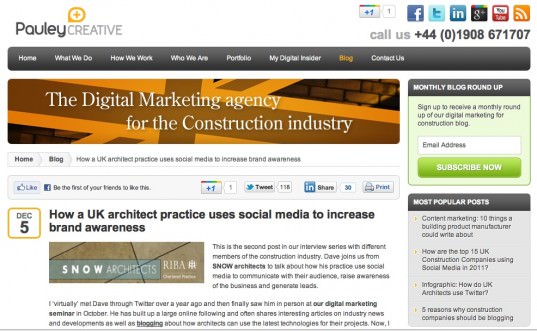8 key issues to review to make sure your blog supports company goals
This is the second in a series of blog posts aimed at helping business bloggers. The first post explored getting started and avoiding writer's block, sometimes an issue at this time of year. In this post, René Power examines the key elements of a successful business blog.
If you're running a business targeting other businesses in 2012, it is likely you have either read about or been advised to introduce a blog to your website. The benefits of business blogging are much chronicled - Dave and Chris both covered it from a commercial and SEO viewpoint.
But with a bewildering choice of over 250 million websites and 130 million blogs (with five million new ones coming online every year), your customers don't have a lot of time or attention. How does a corporate blog attract and retain readers? (Statistics from Go-Globe and Royal Pingdom.)
It's undeniable that setting up, populating and maintaining a content asset like a blog is far from easy. It takes commitment. But thinking strategically about your content, how it is presented, and how it engages, will be time well spent before you 'publish' anything.
1. Keep to topic
Sounds obvious, but pick a topic and stick to it. Visitors are arriving at your blog because they have been directed there, either from a social media link, an Internet search, an email or another reference tool.
You can build a reputation for taking a stance on a particular subject (that has a group of a sufficient size to make it viable). Write about issues that affect them and, subtly the best practice ways of combatting these issues. And remember, if you want to make it more edgier and topical, always relate it back to your industry and your key messages. Pauley Creative, for example, do a great job with their My Digital Insider construction sector blog.

2. Think keywords
Keeping to topic means writing regularly around similar themes. Having a set vocabulary with keywords that serve to optimise your blog and stimulate traffic is a smart approach to take - add them to your content editorial calendar. Use the Google Keyword tool to establish the terms of reference you should be frequently referencing.
3. Be helpful
Above all, don't broadcast. That's what the news page is for. Nothing will turn visitors off quicker than a product / service focused blog. The content posted needs to be useful in order for people to digest and act on it. Lead nurture isn't the number one goal of blogging, but it is a goal. Trust built over time will put you in a much better position to engage regular readers.
4. Get sticky
Keep people coming back. Always leave a blog post with a question, a request or call to action. Build in functionality that allows people to subscribe to comments - often the comments are as insightful as the post itself - and can help build community. Consider other content that might be deployed to keep the visitor on the page. Recommended further reading, free downloads and subscription options all work well. Eloqua, a leading marketing software company, have used blogs and integrated content well in recent years.
5. Follow a formula
Use a template for each blog post. It is human nature to resist change. Look at posts on this site. Wireframe your page establishing where the words and pictures go, what fonts to use, colour palettes, signposts to other content and sharing tools - and stick to it.
The goal is to stimulate regular repeat visits, making it as easy as possible for them to engage with the information provided and faciliate sharing.
6. Talk in multiple voices
It goes without saying that an editorial calendar is a prerequsite. Establish how frequently is realistic and stick to it. My agency blogs every Wednesday and occasionally on a Friday too. Once a month we distribute targeted digests to our clients and prospects in email format. But we have a bank of 30 people to draw on, some admittedly more willing than others! Using multiple authors offers multiple voices and minimises the risk of writer's block and a single tone taking over the blog. (Consider also guest authors too to build your audience and offer variety, but this is a point for the next post).
7. Visually interesting
Design is (almost) as important as content, and not just the elements touched on in point four above. First of all design must be on brand. A business blog will always naturally be looked upon a little differently when compared to a personal blog on account of where it is hosted.
Often embedded blog pages can be made to look significantly different to the website deliberately to encourage participation. Try and use some dynamic elements (HTML5 not Flash if you want to be mobile friendly) to go beyond the static written blog. Take some inspiration from Virgin and tot up how many different blogs they have, the topics they write about and how they look and feel.

8. Lead nurturing
The ultimate goal has to be conversion to your marketing outcomes. You're a business not an academic institution. There is a reason Dave coined the (P)RACE model. Nurturing leads means producing content of interest to targeted visitors that might be stimulated to take their interest further. Look at your blog from a visitor's perspective. Every article and every page has to have an action. Think "so what?" and "what next?" and you won't go far wrong.
What other elements do you think are critical to a business blog? Submit your comments below.
In our next business blogging post, we'll look at seeding and distribution also known as outreach.








